Comprehensive Report on Nervous System Structure and Function
VerifiedAdded on 2023/04/21
|11
|3455
|196
Report
AI Summary
This report provides a comprehensive overview of the nervous system in biology, detailing its basic structure and functions, including the central and peripheral nervous systems, the autonomic nervous system, and the structure of sensory and motor neurons. It explores the nature of nerve impulses, explaining the transmission of action potentials, the all-or-nothing principle, and the roles of the myelin sheath and refractory periods. Furthermore, the report elucidates the principles of synaptic transmission, focusing on the structure of a cholinergic synapse, the role of synapses in the nervous system, and the causes and effects of synaptic inhibition. The document aims to clarify the complex mechanisms underlying neural communication and control within the human body, offering insights into how these systems coordinate and regulate various physiological processes. This assignment solution is available on Desklib, a platform offering a wide range of study resources for students.

Nervous System Biology
Paraphrase This Document
Need a fresh take? Get an instant paraphrase of this document with our AI Paraphraser
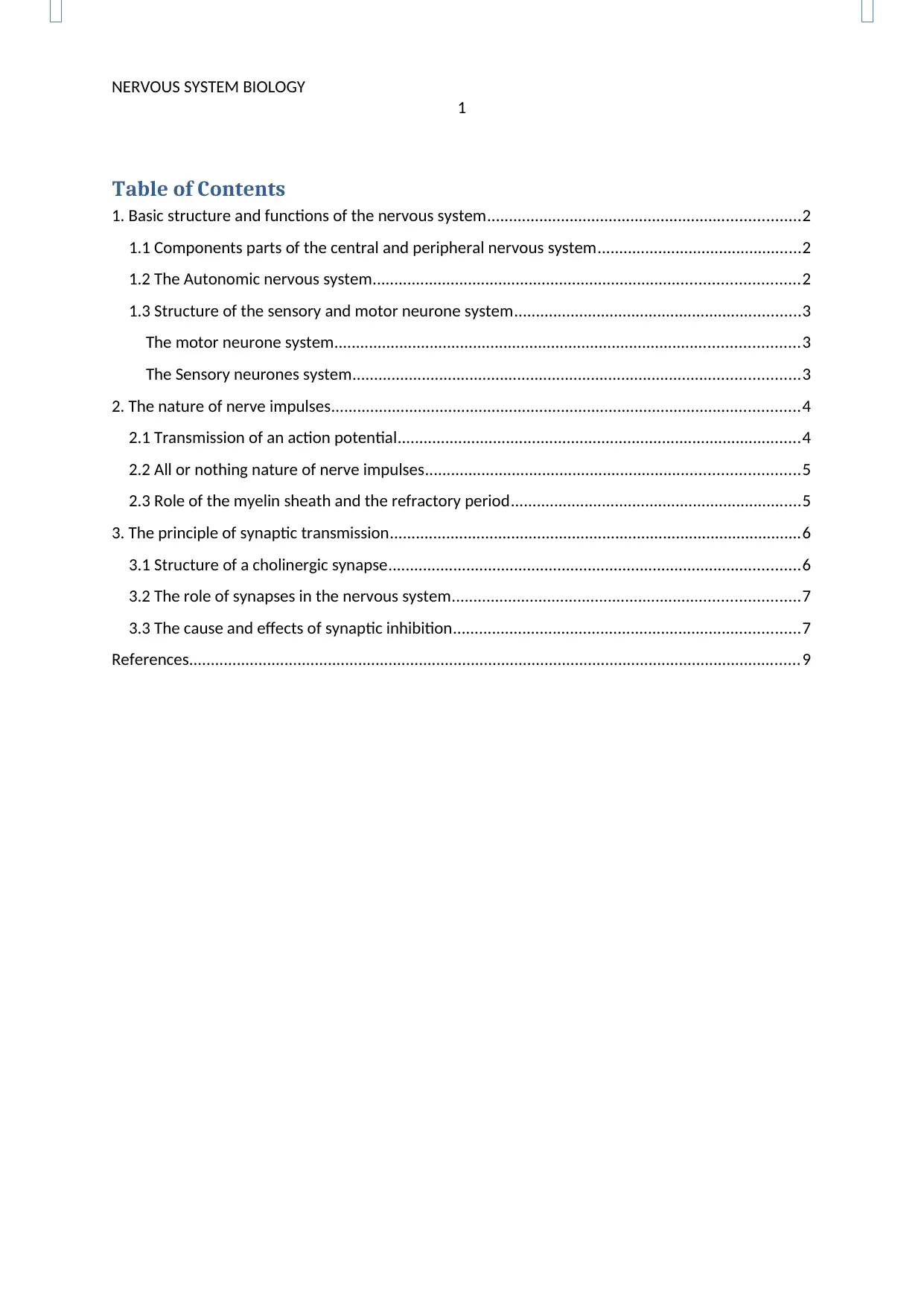
NERVOUS SYSTEM BIOLOGY
1
Table of Contents
1. Basic structure and functions of the nervous system........................................................................2
1.1 Components parts of the central and peripheral nervous system...............................................2
1.2 The Autonomic nervous system..................................................................................................2
1.3 Structure of the sensory and motor neurone system..................................................................3
The motor neurone system...........................................................................................................3
The Sensory neurones system.......................................................................................................3
2. The nature of nerve impulses............................................................................................................4
2.1 Transmission of an action potential.............................................................................................4
2.2 All or nothing nature of nerve impulses......................................................................................5
2.3 Role of the myelin sheath and the refractory period...................................................................5
3. The principle of synaptic transmission...............................................................................................6
3.1 Structure of a cholinergic synapse...............................................................................................6
3.2 The role of synapses in the nervous system................................................................................7
3.3 The cause and effects of synaptic inhibition................................................................................7
References.............................................................................................................................................9
1
Table of Contents
1. Basic structure and functions of the nervous system........................................................................2
1.1 Components parts of the central and peripheral nervous system...............................................2
1.2 The Autonomic nervous system..................................................................................................2
1.3 Structure of the sensory and motor neurone system..................................................................3
The motor neurone system...........................................................................................................3
The Sensory neurones system.......................................................................................................3
2. The nature of nerve impulses............................................................................................................4
2.1 Transmission of an action potential.............................................................................................4
2.2 All or nothing nature of nerve impulses......................................................................................5
2.3 Role of the myelin sheath and the refractory period...................................................................5
3. The principle of synaptic transmission...............................................................................................6
3.1 Structure of a cholinergic synapse...............................................................................................6
3.2 The role of synapses in the nervous system................................................................................7
3.3 The cause and effects of synaptic inhibition................................................................................7
References.............................................................................................................................................9
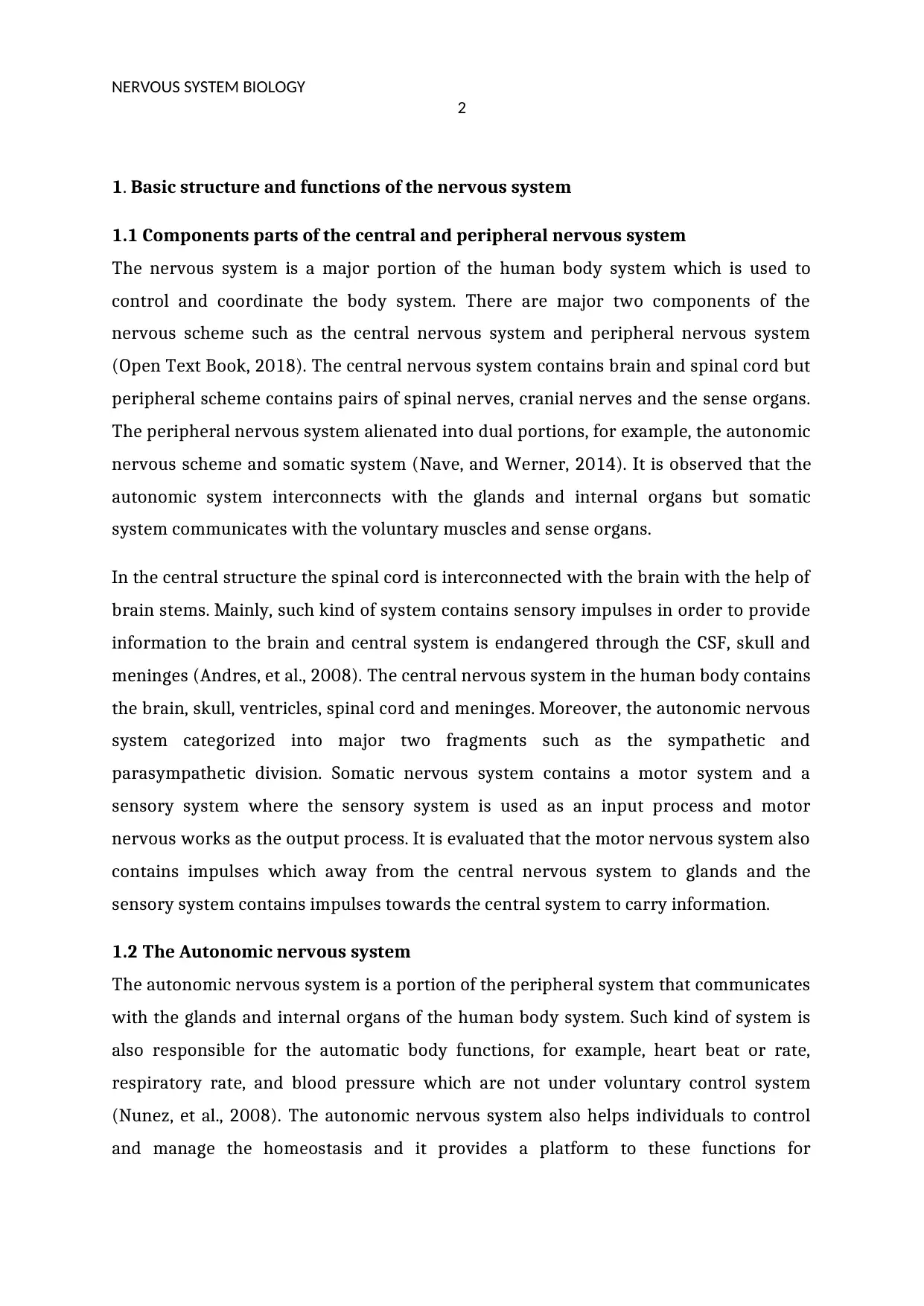
NERVOUS SYSTEM BIOLOGY
2
1. Basic structure and functions of the nervous system
1.1 Components parts of the central and peripheral nervous system
The nervous system is a major portion of the human body system which is used to
control and coordinate the body system. There are major two components of the
nervous scheme such as the central nervous system and peripheral nervous system
(Open Text Book, 2018). The central nervous system contains brain and spinal cord but
peripheral scheme contains pairs of spinal nerves, cranial nerves and the sense organs.
The peripheral nervous system alienated into dual portions, for example, the autonomic
nervous scheme and somatic system (Nave, and Werner, 2014). It is observed that the
autonomic system interconnects with the glands and internal organs but somatic
system communicates with the voluntary muscles and sense organs.
In the central structure the spinal cord is interconnected with the brain with the help of
brain stems. Mainly, such kind of system contains sensory impulses in order to provide
information to the brain and central system is endangered through the CSF, skull and
meninges (Andres, et al., 2008). The central nervous system in the human body contains
the brain, skull, ventricles, spinal cord and meninges. Moreover, the autonomic nervous
system categorized into major two fragments such as the sympathetic and
parasympathetic division. Somatic nervous system contains a motor system and a
sensory system where the sensory system is used as an input process and motor
nervous works as the output process. It is evaluated that the motor nervous system also
contains impulses which away from the central nervous system to glands and the
sensory system contains impulses towards the central system to carry information.
1.2 The Autonomic nervous system
The autonomic nervous system is a portion of the peripheral system that communicates
with the glands and internal organs of the human body system. Such kind of system is
also responsible for the automatic body functions, for example, heart beat or rate,
respiratory rate, and blood pressure which are not under voluntary control system
(Nunez, et al., 2008). The autonomic nervous system also helps individuals to control
and manage the homeostasis and it provides a platform to these functions for
2
1. Basic structure and functions of the nervous system
1.1 Components parts of the central and peripheral nervous system
The nervous system is a major portion of the human body system which is used to
control and coordinate the body system. There are major two components of the
nervous scheme such as the central nervous system and peripheral nervous system
(Open Text Book, 2018). The central nervous system contains brain and spinal cord but
peripheral scheme contains pairs of spinal nerves, cranial nerves and the sense organs.
The peripheral nervous system alienated into dual portions, for example, the autonomic
nervous scheme and somatic system (Nave, and Werner, 2014). It is observed that the
autonomic system interconnects with the glands and internal organs but somatic
system communicates with the voluntary muscles and sense organs.
In the central structure the spinal cord is interconnected with the brain with the help of
brain stems. Mainly, such kind of system contains sensory impulses in order to provide
information to the brain and central system is endangered through the CSF, skull and
meninges (Andres, et al., 2008). The central nervous system in the human body contains
the brain, skull, ventricles, spinal cord and meninges. Moreover, the autonomic nervous
system categorized into major two fragments such as the sympathetic and
parasympathetic division. Somatic nervous system contains a motor system and a
sensory system where the sensory system is used as an input process and motor
nervous works as the output process. It is evaluated that the motor nervous system also
contains impulses which away from the central nervous system to glands and the
sensory system contains impulses towards the central system to carry information.
1.2 The Autonomic nervous system
The autonomic nervous system is a portion of the peripheral system that communicates
with the glands and internal organs of the human body system. Such kind of system is
also responsible for the automatic body functions, for example, heart beat or rate,
respiratory rate, and blood pressure which are not under voluntary control system
(Nunez, et al., 2008). The autonomic nervous system also helps individuals to control
and manage the homeostasis and it provides a platform to these functions for
⊘ This is a preview!⊘
Do you want full access?
Subscribe today to unlock all pages.

Trusted by 1+ million students worldwide
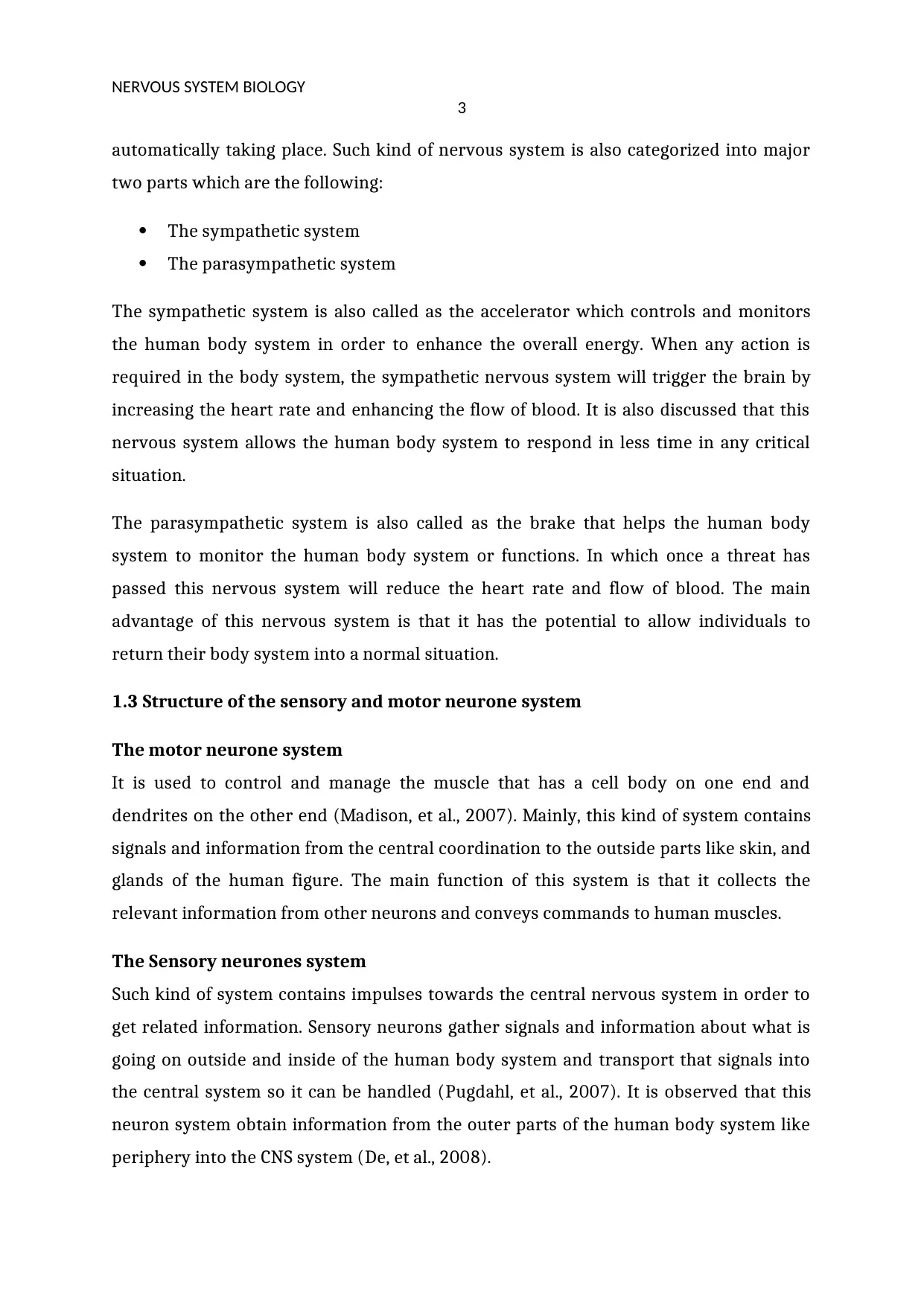
NERVOUS SYSTEM BIOLOGY
3
automatically taking place. Such kind of nervous system is also categorized into major
two parts which are the following:
The sympathetic system
The parasympathetic system
The sympathetic system is also called as the accelerator which controls and monitors
the human body system in order to enhance the overall energy. When any action is
required in the body system, the sympathetic nervous system will trigger the brain by
increasing the heart rate and enhancing the flow of blood. It is also discussed that this
nervous system allows the human body system to respond in less time in any critical
situation.
The parasympathetic system is also called as the brake that helps the human body
system to monitor the human body system or functions. In which once a threat has
passed this nervous system will reduce the heart rate and flow of blood. The main
advantage of this nervous system is that it has the potential to allow individuals to
return their body system into a normal situation.
1.3 Structure of the sensory and motor neurone system
The motor neurone system
It is used to control and manage the muscle that has a cell body on one end and
dendrites on the other end (Madison, et al., 2007). Mainly, this kind of system contains
signals and information from the central coordination to the outside parts like skin, and
glands of the human figure. The main function of this system is that it collects the
relevant information from other neurons and conveys commands to human muscles.
The Sensory neurones system
Such kind of system contains impulses towards the central nervous system in order to
get related information. Sensory neurons gather signals and information about what is
going on outside and inside of the human body system and transport that signals into
the central system so it can be handled (Pugdahl, et al., 2007). It is observed that this
neuron system obtain information from the outer parts of the human body system like
periphery into the CNS system (De, et al., 2008).
3
automatically taking place. Such kind of nervous system is also categorized into major
two parts which are the following:
The sympathetic system
The parasympathetic system
The sympathetic system is also called as the accelerator which controls and monitors
the human body system in order to enhance the overall energy. When any action is
required in the body system, the sympathetic nervous system will trigger the brain by
increasing the heart rate and enhancing the flow of blood. It is also discussed that this
nervous system allows the human body system to respond in less time in any critical
situation.
The parasympathetic system is also called as the brake that helps the human body
system to monitor the human body system or functions. In which once a threat has
passed this nervous system will reduce the heart rate and flow of blood. The main
advantage of this nervous system is that it has the potential to allow individuals to
return their body system into a normal situation.
1.3 Structure of the sensory and motor neurone system
The motor neurone system
It is used to control and manage the muscle that has a cell body on one end and
dendrites on the other end (Madison, et al., 2007). Mainly, this kind of system contains
signals and information from the central coordination to the outside parts like skin, and
glands of the human figure. The main function of this system is that it collects the
relevant information from other neurons and conveys commands to human muscles.
The Sensory neurones system
Such kind of system contains impulses towards the central nervous system in order to
get related information. Sensory neurons gather signals and information about what is
going on outside and inside of the human body system and transport that signals into
the central system so it can be handled (Pugdahl, et al., 2007). It is observed that this
neuron system obtain information from the outer parts of the human body system like
periphery into the CNS system (De, et al., 2008).
Paraphrase This Document
Need a fresh take? Get an instant paraphrase of this document with our AI Paraphraser
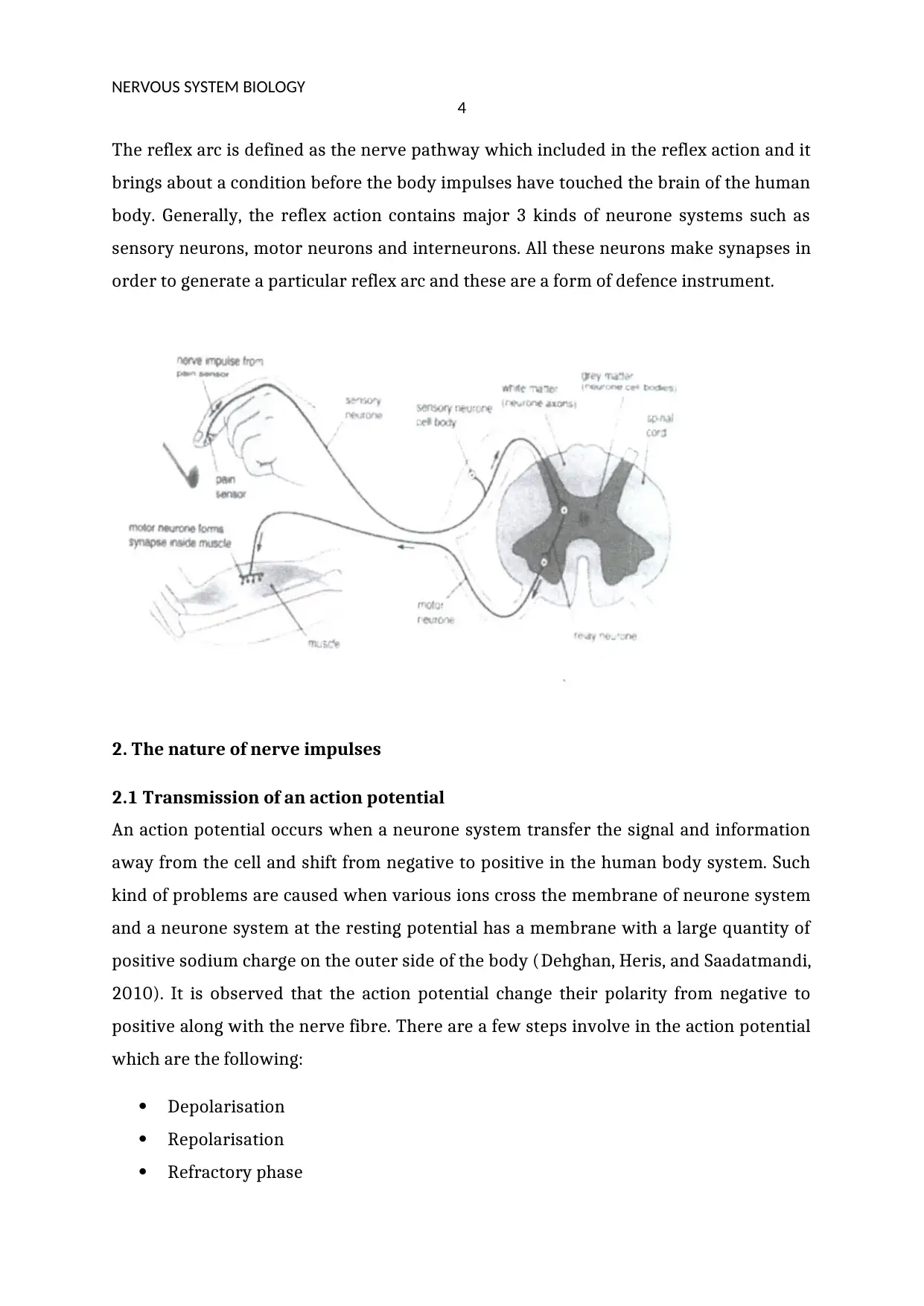
NERVOUS SYSTEM BIOLOGY
4
The reflex arc is defined as the nerve pathway which included in the reflex action and it
brings about a condition before the body impulses have touched the brain of the human
body. Generally, the reflex action contains major 3 kinds of neurone systems such as
sensory neurons, motor neurons and interneurons. All these neurons make synapses in
order to generate a particular reflex arc and these are a form of defence instrument.
2. The nature of nerve impulses
2.1 Transmission of an action potential
An action potential occurs when a neurone system transfer the signal and information
away from the cell and shift from negative to positive in the human body system. Such
kind of problems are caused when various ions cross the membrane of neurone system
and a neurone system at the resting potential has a membrane with a large quantity of
positive sodium charge on the outer side of the body (Dehghan, Heris, and Saadatmandi,
2010). It is observed that the action potential change their polarity from negative to
positive along with the nerve fibre. There are a few steps involve in the action potential
which are the following:
Depolarisation
Repolarisation
Refractory phase
4
The reflex arc is defined as the nerve pathway which included in the reflex action and it
brings about a condition before the body impulses have touched the brain of the human
body. Generally, the reflex action contains major 3 kinds of neurone systems such as
sensory neurons, motor neurons and interneurons. All these neurons make synapses in
order to generate a particular reflex arc and these are a form of defence instrument.
2. The nature of nerve impulses
2.1 Transmission of an action potential
An action potential occurs when a neurone system transfer the signal and information
away from the cell and shift from negative to positive in the human body system. Such
kind of problems are caused when various ions cross the membrane of neurone system
and a neurone system at the resting potential has a membrane with a large quantity of
positive sodium charge on the outer side of the body (Dehghan, Heris, and Saadatmandi,
2010). It is observed that the action potential change their polarity from negative to
positive along with the nerve fibre. There are a few steps involve in the action potential
which are the following:
Depolarisation
Repolarisation
Refractory phase
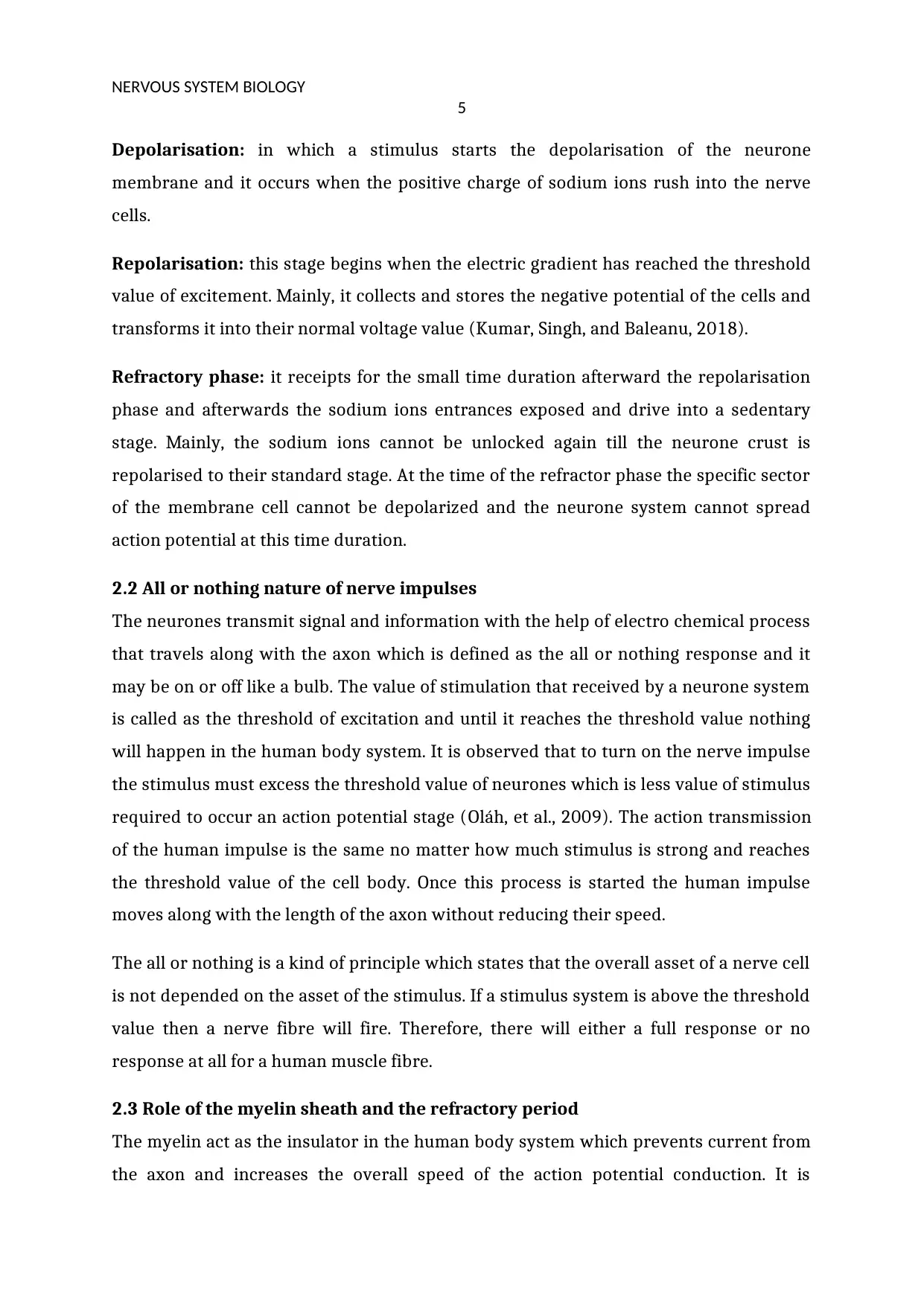
NERVOUS SYSTEM BIOLOGY
5
Depolarisation: in which a stimulus starts the depolarisation of the neurone
membrane and it occurs when the positive charge of sodium ions rush into the nerve
cells.
Repolarisation: this stage begins when the electric gradient has reached the threshold
value of excitement. Mainly, it collects and stores the negative potential of the cells and
transforms it into their normal voltage value (Kumar, Singh, and Baleanu, 2018).
Refractory phase: it receipts for the small time duration afterward the repolarisation
phase and afterwards the sodium ions entrances exposed and drive into a sedentary
stage. Mainly, the sodium ions cannot be unlocked again till the neurone crust is
repolarised to their standard stage. At the time of the refractor phase the specific sector
of the membrane cell cannot be depolarized and the neurone system cannot spread
action potential at this time duration.
2.2 All or nothing nature of nerve impulses
The neurones transmit signal and information with the help of electro chemical process
that travels along with the axon which is defined as the all or nothing response and it
may be on or off like a bulb. The value of stimulation that received by a neurone system
is called as the threshold of excitation and until it reaches the threshold value nothing
will happen in the human body system. It is observed that to turn on the nerve impulse
the stimulus must excess the threshold value of neurones which is less value of stimulus
required to occur an action potential stage (Oláh, et al., 2009). The action transmission
of the human impulse is the same no matter how much stimulus is strong and reaches
the threshold value of the cell body. Once this process is started the human impulse
moves along with the length of the axon without reducing their speed.
The all or nothing is a kind of principle which states that the overall asset of a nerve cell
is not depended on the asset of the stimulus. If a stimulus system is above the threshold
value then a nerve fibre will fire. Therefore, there will either a full response or no
response at all for a human muscle fibre.
2.3 Role of the myelin sheath and the refractory period
The myelin act as the insulator in the human body system which prevents current from
the axon and increases the overall speed of the action potential conduction. It is
5
Depolarisation: in which a stimulus starts the depolarisation of the neurone
membrane and it occurs when the positive charge of sodium ions rush into the nerve
cells.
Repolarisation: this stage begins when the electric gradient has reached the threshold
value of excitement. Mainly, it collects and stores the negative potential of the cells and
transforms it into their normal voltage value (Kumar, Singh, and Baleanu, 2018).
Refractory phase: it receipts for the small time duration afterward the repolarisation
phase and afterwards the sodium ions entrances exposed and drive into a sedentary
stage. Mainly, the sodium ions cannot be unlocked again till the neurone crust is
repolarised to their standard stage. At the time of the refractor phase the specific sector
of the membrane cell cannot be depolarized and the neurone system cannot spread
action potential at this time duration.
2.2 All or nothing nature of nerve impulses
The neurones transmit signal and information with the help of electro chemical process
that travels along with the axon which is defined as the all or nothing response and it
may be on or off like a bulb. The value of stimulation that received by a neurone system
is called as the threshold of excitation and until it reaches the threshold value nothing
will happen in the human body system. It is observed that to turn on the nerve impulse
the stimulus must excess the threshold value of neurones which is less value of stimulus
required to occur an action potential stage (Oláh, et al., 2009). The action transmission
of the human impulse is the same no matter how much stimulus is strong and reaches
the threshold value of the cell body. Once this process is started the human impulse
moves along with the length of the axon without reducing their speed.
The all or nothing is a kind of principle which states that the overall asset of a nerve cell
is not depended on the asset of the stimulus. If a stimulus system is above the threshold
value then a nerve fibre will fire. Therefore, there will either a full response or no
response at all for a human muscle fibre.
2.3 Role of the myelin sheath and the refractory period
The myelin act as the insulator in the human body system which prevents current from
the axon and increases the overall speed of the action potential conduction. It is
⊘ This is a preview!⊘
Do you want full access?
Subscribe today to unlock all pages.

Trusted by 1+ million students worldwide
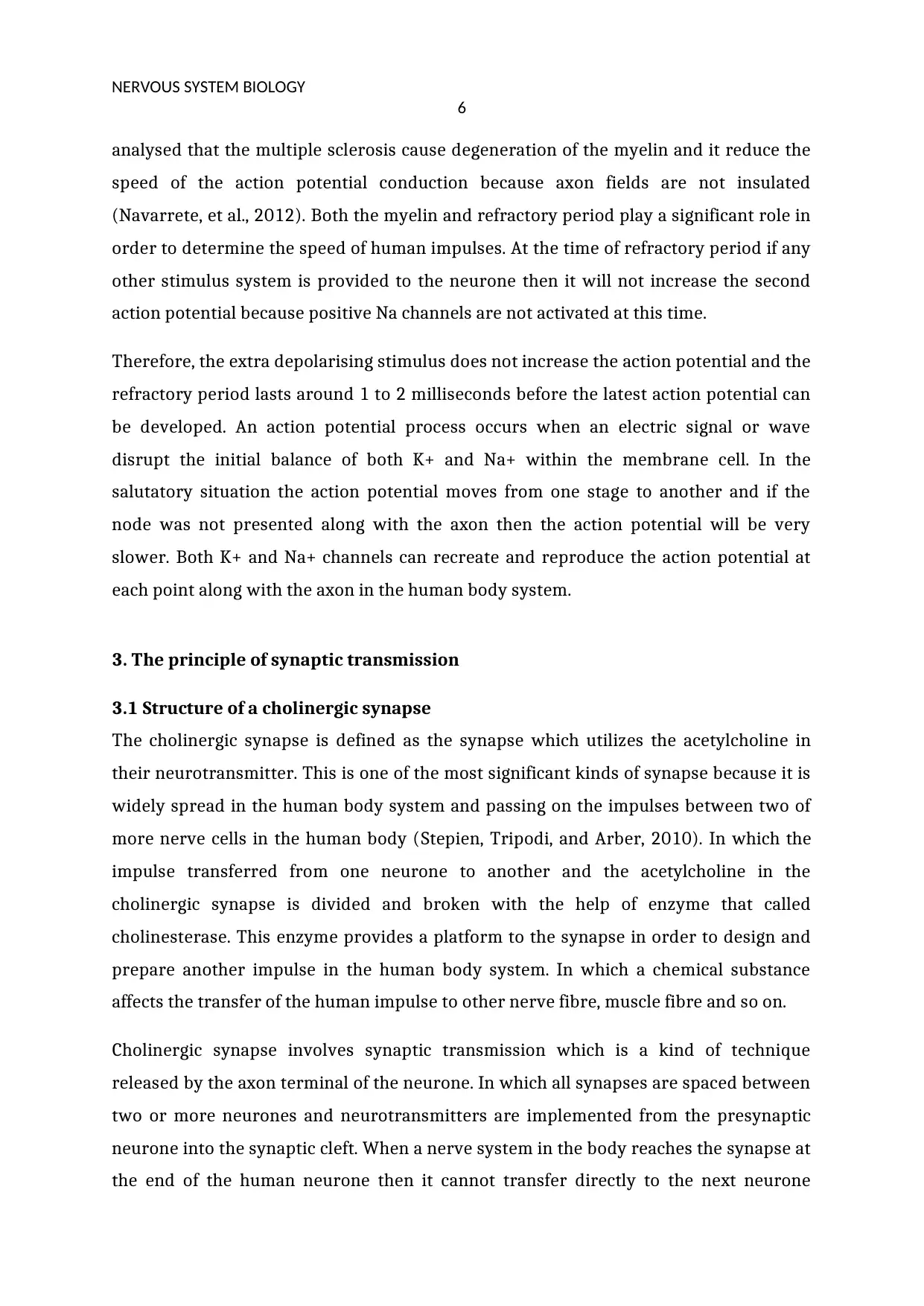
NERVOUS SYSTEM BIOLOGY
6
analysed that the multiple sclerosis cause degeneration of the myelin and it reduce the
speed of the action potential conduction because axon fields are not insulated
(Navarrete, et al., 2012). Both the myelin and refractory period play a significant role in
order to determine the speed of human impulses. At the time of refractory period if any
other stimulus system is provided to the neurone then it will not increase the second
action potential because positive Na channels are not activated at this time.
Therefore, the extra depolarising stimulus does not increase the action potential and the
refractory period lasts around 1 to 2 milliseconds before the latest action potential can
be developed. An action potential process occurs when an electric signal or wave
disrupt the initial balance of both K+ and Na+ within the membrane cell. In the
salutatory situation the action potential moves from one stage to another and if the
node was not presented along with the axon then the action potential will be very
slower. Both K+ and Na+ channels can recreate and reproduce the action potential at
each point along with the axon in the human body system.
3. The principle of synaptic transmission
3.1 Structure of a cholinergic synapse
The cholinergic synapse is defined as the synapse which utilizes the acetylcholine in
their neurotransmitter. This is one of the most significant kinds of synapse because it is
widely spread in the human body system and passing on the impulses between two of
more nerve cells in the human body (Stepien, Tripodi, and Arber, 2010). In which the
impulse transferred from one neurone to another and the acetylcholine in the
cholinergic synapse is divided and broken with the help of enzyme that called
cholinesterase. This enzyme provides a platform to the synapse in order to design and
prepare another impulse in the human body system. In which a chemical substance
affects the transfer of the human impulse to other nerve fibre, muscle fibre and so on.
Cholinergic synapse involves synaptic transmission which is a kind of technique
released by the axon terminal of the neurone. In which all synapses are spaced between
two or more neurones and neurotransmitters are implemented from the presynaptic
neurone into the synaptic cleft. When a nerve system in the body reaches the synapse at
the end of the human neurone then it cannot transfer directly to the next neurone
6
analysed that the multiple sclerosis cause degeneration of the myelin and it reduce the
speed of the action potential conduction because axon fields are not insulated
(Navarrete, et al., 2012). Both the myelin and refractory period play a significant role in
order to determine the speed of human impulses. At the time of refractory period if any
other stimulus system is provided to the neurone then it will not increase the second
action potential because positive Na channels are not activated at this time.
Therefore, the extra depolarising stimulus does not increase the action potential and the
refractory period lasts around 1 to 2 milliseconds before the latest action potential can
be developed. An action potential process occurs when an electric signal or wave
disrupt the initial balance of both K+ and Na+ within the membrane cell. In the
salutatory situation the action potential moves from one stage to another and if the
node was not presented along with the axon then the action potential will be very
slower. Both K+ and Na+ channels can recreate and reproduce the action potential at
each point along with the axon in the human body system.
3. The principle of synaptic transmission
3.1 Structure of a cholinergic synapse
The cholinergic synapse is defined as the synapse which utilizes the acetylcholine in
their neurotransmitter. This is one of the most significant kinds of synapse because it is
widely spread in the human body system and passing on the impulses between two of
more nerve cells in the human body (Stepien, Tripodi, and Arber, 2010). In which the
impulse transferred from one neurone to another and the acetylcholine in the
cholinergic synapse is divided and broken with the help of enzyme that called
cholinesterase. This enzyme provides a platform to the synapse in order to design and
prepare another impulse in the human body system. In which a chemical substance
affects the transfer of the human impulse to other nerve fibre, muscle fibre and so on.
Cholinergic synapse involves synaptic transmission which is a kind of technique
released by the axon terminal of the neurone. In which all synapses are spaced between
two or more neurones and neurotransmitters are implemented from the presynaptic
neurone into the synaptic cleft. When a nerve system in the body reaches the synapse at
the end of the human neurone then it cannot transfer directly to the next neurone
Paraphrase This Document
Need a fresh take? Get an instant paraphrase of this document with our AI Paraphraser
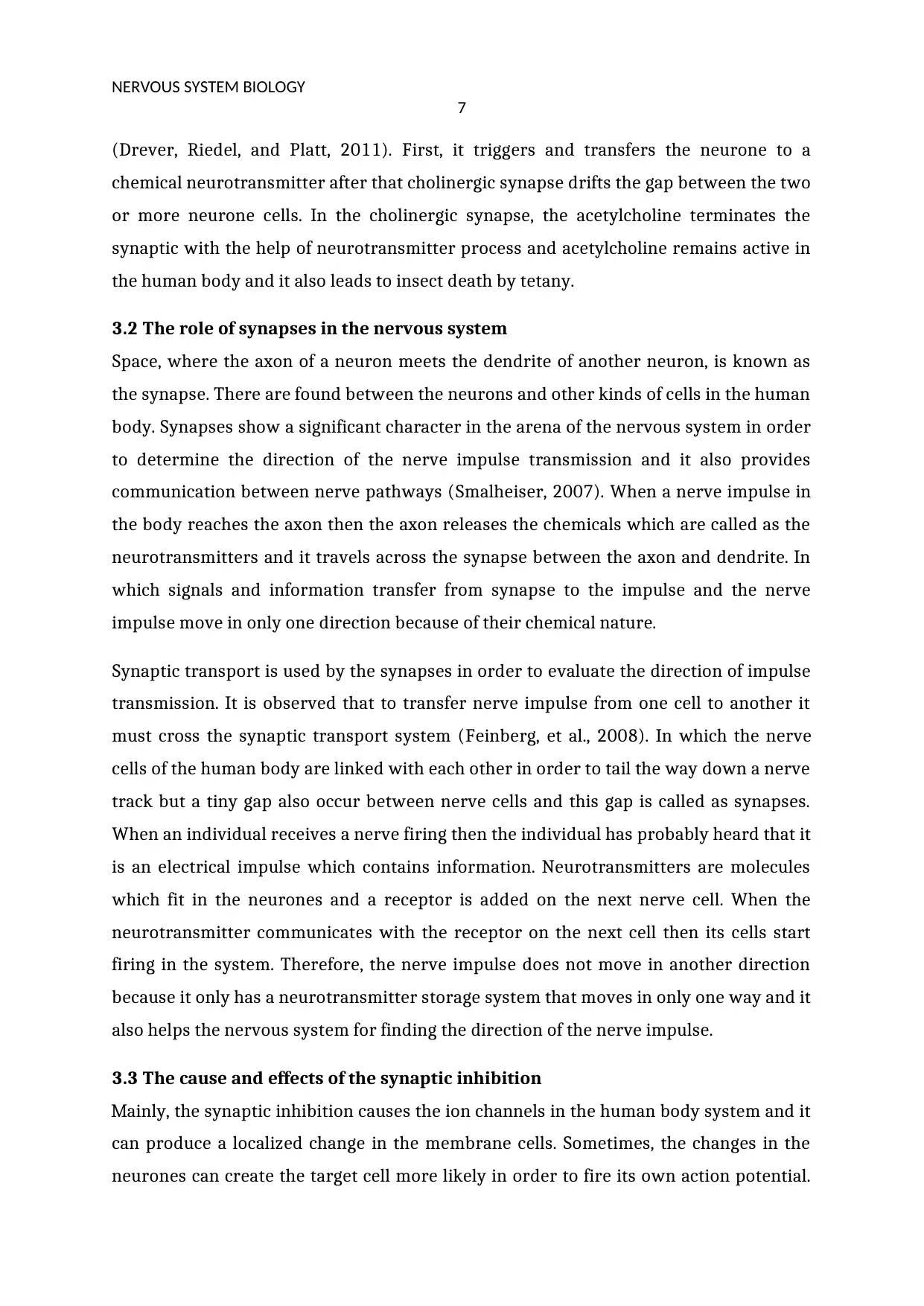
NERVOUS SYSTEM BIOLOGY
7
(Drever, Riedel, and Platt, 2011). First, it triggers and transfers the neurone to a
chemical neurotransmitter after that cholinergic synapse drifts the gap between the two
or more neurone cells. In the cholinergic synapse, the acetylcholine terminates the
synaptic with the help of neurotransmitter process and acetylcholine remains active in
the human body and it also leads to insect death by tetany.
3.2 The role of synapses in the nervous system
Space, where the axon of a neuron meets the dendrite of another neuron, is known as
the synapse. There are found between the neurons and other kinds of cells in the human
body. Synapses show a significant character in the arena of the nervous system in order
to determine the direction of the nerve impulse transmission and it also provides
communication between nerve pathways (Smalheiser, 2007). When a nerve impulse in
the body reaches the axon then the axon releases the chemicals which are called as the
neurotransmitters and it travels across the synapse between the axon and dendrite. In
which signals and information transfer from synapse to the impulse and the nerve
impulse move in only one direction because of their chemical nature.
Synaptic transport is used by the synapses in order to evaluate the direction of impulse
transmission. It is observed that to transfer nerve impulse from one cell to another it
must cross the synaptic transport system (Feinberg, et al., 2008). In which the nerve
cells of the human body are linked with each other in order to tail the way down a nerve
track but a tiny gap also occur between nerve cells and this gap is called as synapses.
When an individual receives a nerve firing then the individual has probably heard that it
is an electrical impulse which contains information. Neurotransmitters are molecules
which fit in the neurones and a receptor is added on the next nerve cell. When the
neurotransmitter communicates with the receptor on the next cell then its cells start
firing in the system. Therefore, the nerve impulse does not move in another direction
because it only has a neurotransmitter storage system that moves in only one way and it
also helps the nervous system for finding the direction of the nerve impulse.
3.3 The cause and effects of the synaptic inhibition
Mainly, the synaptic inhibition causes the ion channels in the human body system and it
can produce a localized change in the membrane cells. Sometimes, the changes in the
neurones can create the target cell more likely in order to fire its own action potential.
7
(Drever, Riedel, and Platt, 2011). First, it triggers and transfers the neurone to a
chemical neurotransmitter after that cholinergic synapse drifts the gap between the two
or more neurone cells. In the cholinergic synapse, the acetylcholine terminates the
synaptic with the help of neurotransmitter process and acetylcholine remains active in
the human body and it also leads to insect death by tetany.
3.2 The role of synapses in the nervous system
Space, where the axon of a neuron meets the dendrite of another neuron, is known as
the synapse. There are found between the neurons and other kinds of cells in the human
body. Synapses show a significant character in the arena of the nervous system in order
to determine the direction of the nerve impulse transmission and it also provides
communication between nerve pathways (Smalheiser, 2007). When a nerve impulse in
the body reaches the axon then the axon releases the chemicals which are called as the
neurotransmitters and it travels across the synapse between the axon and dendrite. In
which signals and information transfer from synapse to the impulse and the nerve
impulse move in only one direction because of their chemical nature.
Synaptic transport is used by the synapses in order to evaluate the direction of impulse
transmission. It is observed that to transfer nerve impulse from one cell to another it
must cross the synaptic transport system (Feinberg, et al., 2008). In which the nerve
cells of the human body are linked with each other in order to tail the way down a nerve
track but a tiny gap also occur between nerve cells and this gap is called as synapses.
When an individual receives a nerve firing then the individual has probably heard that it
is an electrical impulse which contains information. Neurotransmitters are molecules
which fit in the neurones and a receptor is added on the next nerve cell. When the
neurotransmitter communicates with the receptor on the next cell then its cells start
firing in the system. Therefore, the nerve impulse does not move in another direction
because it only has a neurotransmitter storage system that moves in only one way and it
also helps the nervous system for finding the direction of the nerve impulse.
3.3 The cause and effects of the synaptic inhibition
Mainly, the synaptic inhibition causes the ion channels in the human body system and it
can produce a localized change in the membrane cells. Sometimes, the changes in the
neurones can create the target cell more likely in order to fire its own action potential.
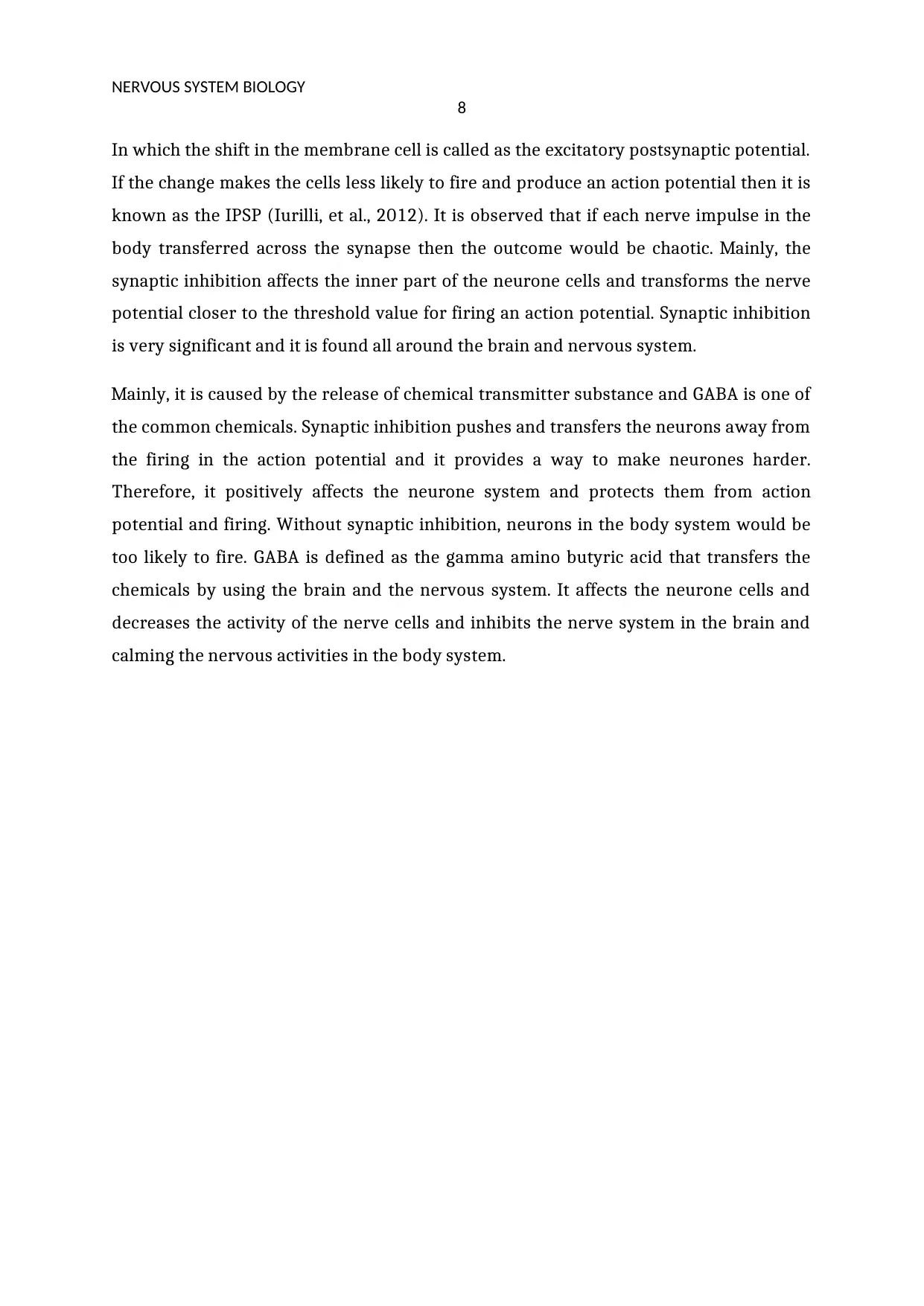
NERVOUS SYSTEM BIOLOGY
8
In which the shift in the membrane cell is called as the excitatory postsynaptic potential.
If the change makes the cells less likely to fire and produce an action potential then it is
known as the IPSP (Iurilli, et al., 2012). It is observed that if each nerve impulse in the
body transferred across the synapse then the outcome would be chaotic. Mainly, the
synaptic inhibition affects the inner part of the neurone cells and transforms the nerve
potential closer to the threshold value for firing an action potential. Synaptic inhibition
is very significant and it is found all around the brain and nervous system.
Mainly, it is caused by the release of chemical transmitter substance and GABA is one of
the common chemicals. Synaptic inhibition pushes and transfers the neurons away from
the firing in the action potential and it provides a way to make neurones harder.
Therefore, it positively affects the neurone system and protects them from action
potential and firing. Without synaptic inhibition, neurons in the body system would be
too likely to fire. GABA is defined as the gamma amino butyric acid that transfers the
chemicals by using the brain and the nervous system. It affects the neurone cells and
decreases the activity of the nerve cells and inhibits the nerve system in the brain and
calming the nervous activities in the body system.
8
In which the shift in the membrane cell is called as the excitatory postsynaptic potential.
If the change makes the cells less likely to fire and produce an action potential then it is
known as the IPSP (Iurilli, et al., 2012). It is observed that if each nerve impulse in the
body transferred across the synapse then the outcome would be chaotic. Mainly, the
synaptic inhibition affects the inner part of the neurone cells and transforms the nerve
potential closer to the threshold value for firing an action potential. Synaptic inhibition
is very significant and it is found all around the brain and nervous system.
Mainly, it is caused by the release of chemical transmitter substance and GABA is one of
the common chemicals. Synaptic inhibition pushes and transfers the neurons away from
the firing in the action potential and it provides a way to make neurones harder.
Therefore, it positively affects the neurone system and protects them from action
potential and firing. Without synaptic inhibition, neurons in the body system would be
too likely to fire. GABA is defined as the gamma amino butyric acid that transfers the
chemicals by using the brain and the nervous system. It affects the neurone cells and
decreases the activity of the nerve cells and inhibits the nerve system in the brain and
calming the nervous activities in the body system.
⊘ This is a preview!⊘
Do you want full access?
Subscribe today to unlock all pages.

Trusted by 1+ million students worldwide
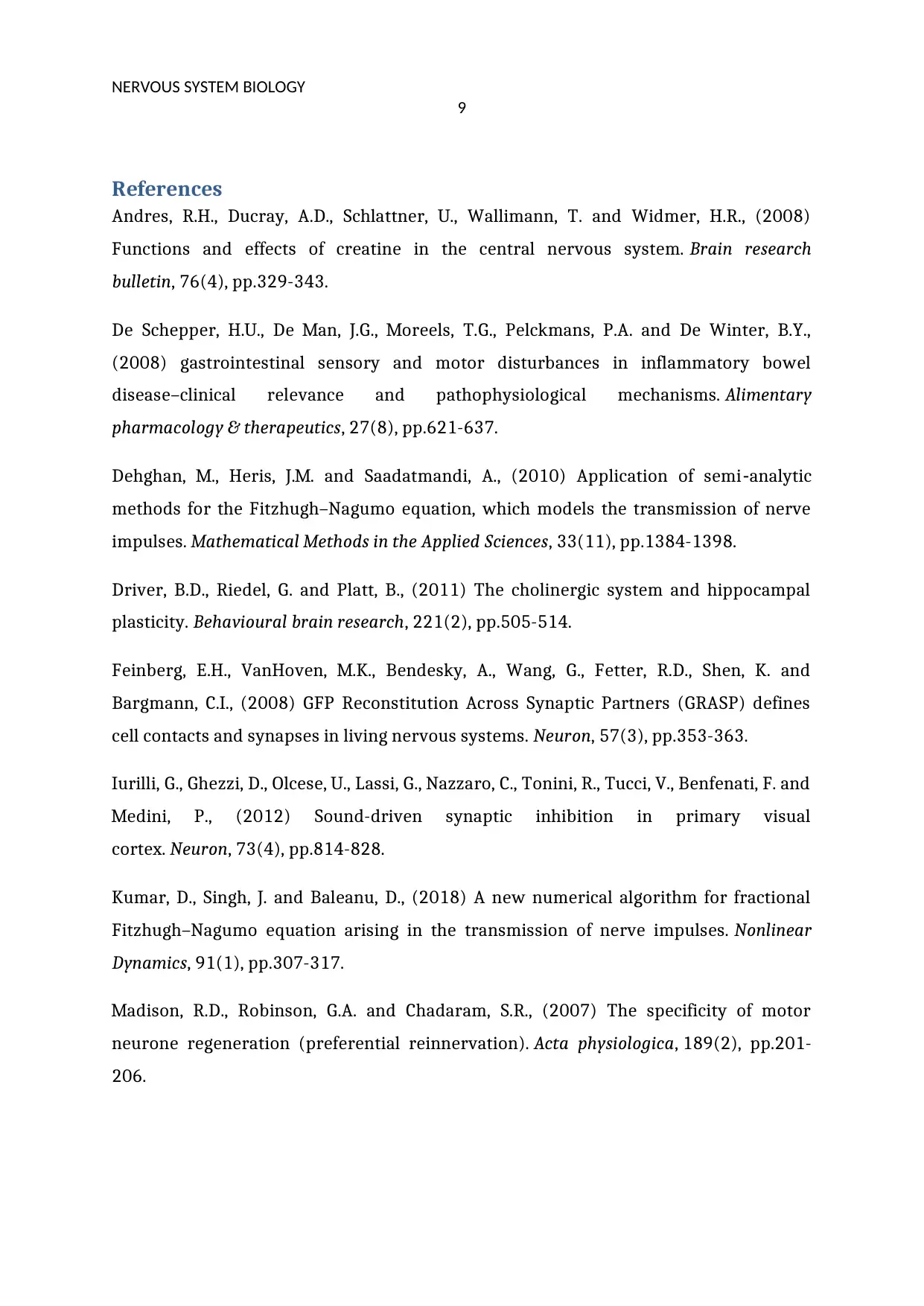
NERVOUS SYSTEM BIOLOGY
9
References
Andres, R.H., Ducray, A.D., Schlattner, U., Wallimann, T. and Widmer, H.R., (2008)
Functions and effects of creatine in the central nervous system. Brain research
bulletin, 76(4), pp.329-343.
De Schepper, H.U., De Man, J.G., Moreels, T.G., Pelckmans, P.A. and De Winter, B.Y.,
(2008) gastrointestinal sensory and motor disturbances in inflammatory bowel
disease–clinical relevance and pathophysiological mechanisms. Alimentary
pharmacology & therapeutics, 27(8), pp.621-637.
Dehghan, M., Heris, J.M. and Saadatmandi, A., (2010) Application of semi‐analytic
methods for the Fitzhugh–Nagumo equation, which models the transmission of nerve
impulses. Mathematical Methods in the Applied Sciences, 33(11), pp.1384-1398.
Driver, B.D., Riedel, G. and Platt, B., (2011) The cholinergic system and hippocampal
plasticity. Behavioural brain research, 221(2), pp.505-514.
Feinberg, E.H., VanHoven, M.K., Bendesky, A., Wang, G., Fetter, R.D., Shen, K. and
Bargmann, C.I., (2008) GFP Reconstitution Across Synaptic Partners (GRASP) defines
cell contacts and synapses in living nervous systems. Neuron, 57(3), pp.353-363.
Iurilli, G., Ghezzi, D., Olcese, U., Lassi, G., Nazzaro, C., Tonini, R., Tucci, V., Benfenati, F. and
Medini, P., (2012) Sound-driven synaptic inhibition in primary visual
cortex. Neuron, 73(4), pp.814-828.
Kumar, D., Singh, J. and Baleanu, D., (2018) A new numerical algorithm for fractional
Fitzhugh–Nagumo equation arising in the transmission of nerve impulses. Nonlinear
Dynamics, 91(1), pp.307-317.
Madison, R.D., Robinson, G.A. and Chadaram, S.R., (2007) The specificity of motor
neurone regeneration (preferential reinnervation). Acta physiologica, 189(2), pp.201-
206.
9
References
Andres, R.H., Ducray, A.D., Schlattner, U., Wallimann, T. and Widmer, H.R., (2008)
Functions and effects of creatine in the central nervous system. Brain research
bulletin, 76(4), pp.329-343.
De Schepper, H.U., De Man, J.G., Moreels, T.G., Pelckmans, P.A. and De Winter, B.Y.,
(2008) gastrointestinal sensory and motor disturbances in inflammatory bowel
disease–clinical relevance and pathophysiological mechanisms. Alimentary
pharmacology & therapeutics, 27(8), pp.621-637.
Dehghan, M., Heris, J.M. and Saadatmandi, A., (2010) Application of semi‐analytic
methods for the Fitzhugh–Nagumo equation, which models the transmission of nerve
impulses. Mathematical Methods in the Applied Sciences, 33(11), pp.1384-1398.
Driver, B.D., Riedel, G. and Platt, B., (2011) The cholinergic system and hippocampal
plasticity. Behavioural brain research, 221(2), pp.505-514.
Feinberg, E.H., VanHoven, M.K., Bendesky, A., Wang, G., Fetter, R.D., Shen, K. and
Bargmann, C.I., (2008) GFP Reconstitution Across Synaptic Partners (GRASP) defines
cell contacts and synapses in living nervous systems. Neuron, 57(3), pp.353-363.
Iurilli, G., Ghezzi, D., Olcese, U., Lassi, G., Nazzaro, C., Tonini, R., Tucci, V., Benfenati, F. and
Medini, P., (2012) Sound-driven synaptic inhibition in primary visual
cortex. Neuron, 73(4), pp.814-828.
Kumar, D., Singh, J. and Baleanu, D., (2018) A new numerical algorithm for fractional
Fitzhugh–Nagumo equation arising in the transmission of nerve impulses. Nonlinear
Dynamics, 91(1), pp.307-317.
Madison, R.D., Robinson, G.A. and Chadaram, S.R., (2007) The specificity of motor
neurone regeneration (preferential reinnervation). Acta physiologica, 189(2), pp.201-
206.
Paraphrase This Document
Need a fresh take? Get an instant paraphrase of this document with our AI Paraphraser
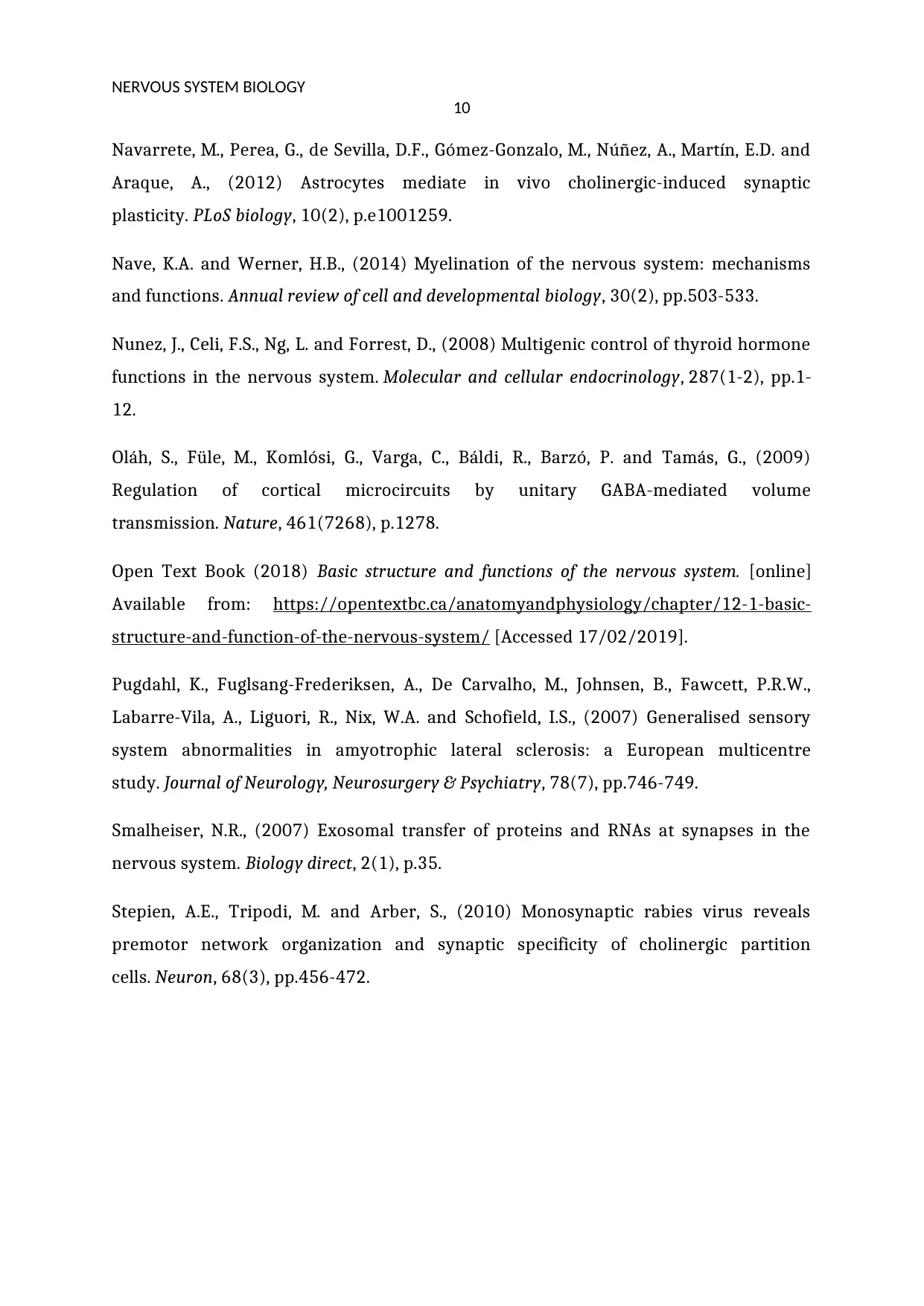
NERVOUS SYSTEM BIOLOGY
10
Navarrete, M., Perea, G., de Sevilla, D.F., Gómez-Gonzalo, M., Núñez, A., Martín, E.D. and
Araque, A., (2012) Astrocytes mediate in vivo cholinergic-induced synaptic
plasticity. PLoS biology, 10(2), p.e1001259.
Nave, K.A. and Werner, H.B., (2014) Myelination of the nervous system: mechanisms
and functions. Annual review of cell and developmental biology, 30(2), pp.503-533.
Nunez, J., Celi, F.S., Ng, L. and Forrest, D., (2008) Multigenic control of thyroid hormone
functions in the nervous system. Molecular and cellular endocrinology, 287(1-2), pp.1-
12.
Oláh, S., Füle, M., Komlósi, G., Varga, C., Báldi, R., Barzó, P. and Tamás, G., (2009)
Regulation of cortical microcircuits by unitary GABA-mediated volume
transmission. Nature, 461(7268), p.1278.
Open Text Book (2018) Basic structure and functions of the nervous system. [online]
Available from: https://opentextbc.ca/anatomyandphysiology/chapter/12-1-basic-
structure-and-function-of-the-nervous-system/ [Accessed 17/02/2019].
Pugdahl, K., Fuglsang-Frederiksen, A., De Carvalho, M., Johnsen, B., Fawcett, P.R.W.,
Labarre-Vila, A., Liguori, R., Nix, W.A. and Schofield, I.S., (2007) Generalised sensory
system abnormalities in amyotrophic lateral sclerosis: a European multicentre
study. Journal of Neurology, Neurosurgery & Psychiatry, 78(7), pp.746-749.
Smalheiser, N.R., (2007) Exosomal transfer of proteins and RNAs at synapses in the
nervous system. Biology direct, 2(1), p.35.
Stepien, A.E., Tripodi, M. and Arber, S., (2010) Monosynaptic rabies virus reveals
premotor network organization and synaptic specificity of cholinergic partition
cells. Neuron, 68(3), pp.456-472.
10
Navarrete, M., Perea, G., de Sevilla, D.F., Gómez-Gonzalo, M., Núñez, A., Martín, E.D. and
Araque, A., (2012) Astrocytes mediate in vivo cholinergic-induced synaptic
plasticity. PLoS biology, 10(2), p.e1001259.
Nave, K.A. and Werner, H.B., (2014) Myelination of the nervous system: mechanisms
and functions. Annual review of cell and developmental biology, 30(2), pp.503-533.
Nunez, J., Celi, F.S., Ng, L. and Forrest, D., (2008) Multigenic control of thyroid hormone
functions in the nervous system. Molecular and cellular endocrinology, 287(1-2), pp.1-
12.
Oláh, S., Füle, M., Komlósi, G., Varga, C., Báldi, R., Barzó, P. and Tamás, G., (2009)
Regulation of cortical microcircuits by unitary GABA-mediated volume
transmission. Nature, 461(7268), p.1278.
Open Text Book (2018) Basic structure and functions of the nervous system. [online]
Available from: https://opentextbc.ca/anatomyandphysiology/chapter/12-1-basic-
structure-and-function-of-the-nervous-system/ [Accessed 17/02/2019].
Pugdahl, K., Fuglsang-Frederiksen, A., De Carvalho, M., Johnsen, B., Fawcett, P.R.W.,
Labarre-Vila, A., Liguori, R., Nix, W.A. and Schofield, I.S., (2007) Generalised sensory
system abnormalities in amyotrophic lateral sclerosis: a European multicentre
study. Journal of Neurology, Neurosurgery & Psychiatry, 78(7), pp.746-749.
Smalheiser, N.R., (2007) Exosomal transfer of proteins and RNAs at synapses in the
nervous system. Biology direct, 2(1), p.35.
Stepien, A.E., Tripodi, M. and Arber, S., (2010) Monosynaptic rabies virus reveals
premotor network organization and synaptic specificity of cholinergic partition
cells. Neuron, 68(3), pp.456-472.
1 out of 11
Related Documents
Your All-in-One AI-Powered Toolkit for Academic Success.
+13062052269
info@desklib.com
Available 24*7 on WhatsApp / Email
![[object Object]](/_next/static/media/star-bottom.7253800d.svg)
Unlock your academic potential
Copyright © 2020–2025 A2Z Services. All Rights Reserved. Developed and managed by ZUCOL.





